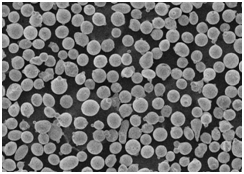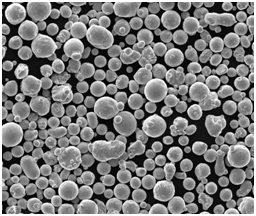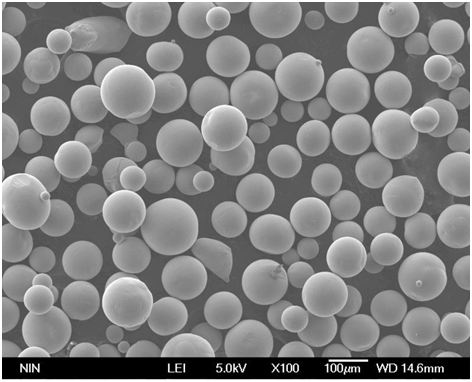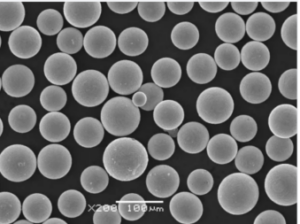Overview of Haynes 230 Powder
Haynes 230 powder is an incredibly high-performance nickel-based alloy, engineered to thrive in environments requiring resistance to extreme temperatures and oxidizing conditions. Renowned for its exceptional strength and resistance to oxidation, Haynes 230 powder finds widespread use in aerospace, industrial gas turbines, and chemical processing industries. The alloy maintains its mechanical properties at elevated temperatures, making it an ideal choice for critical high-temperature applications.
In this comprehensive guide, we’ll dive into the properties, applications, and specifications of Haynes 230 powder. Whether you’re exploring material options for high-temperature environments or looking to understand how Haynes 230 powder compares to other metal powders, this article provides everything you need to know.

Composition of Haynes 230 Powder
Haynes 230 powder is formulated from a carefully balanced mixture of elements that provide its impressive properties. The major components of Haynes 230 powder include nickel, chromium, tungsten, and molybdenum. Each of these elements contributes to the alloy’s high-temperature strength, oxidation resistance, and fabricability.
Key Components in Haynes 230 Powder:
| Element | Percentage (%) | Function |
|---|---|---|
| Nickel (Ni) | 55-65% | Provides corrosion resistance and toughness |
| Chromium (Cr) | 20-24% | Increases oxidation resistance at high temperatures |
| Tungsten (W) | 13-15% | Enhances creep strength and high-temperature durability |
| Molybdenum (Mo) | 1-3% | Adds to overall strength and resistance to thermal fatigue |
| Iron (Fe) | 3% max | Residual impurity, sometimes intentionally added in small amounts |
| Cobalt (Co) | 5% max | Improves strength and resistance to wear in high-temp settings |
This combination makes Haynes 230 powder stand out for its high-performance characteristics, even compared to other nickel-based superalloys. The optimized balance of these metals ensures its strength in extreme operating environments.
Characteristics of Haynes 230 Powder
Haynes 230 powder isn’t just another metal powder; it’s an engineering marvel. Its features allow it to endure both the mechanical stress and chemical degradation that come with high-temperature industrial applications. Below are the key properties of Haynes 230 powder.
Key Characteristics:
| Characteristic | Details |
|---|---|
| High-Temperature Strength | Exceptional strength retention up to 1150°C |
| Oxidation Resistance | Excellent oxidation resistance up to 1200°C |
| Creep Resistance | Maintains mechanical integrity over long periods under stress and heat |
| Thermal Fatigue Resistance | Withstands cyclic heating and cooling without cracking or deforming |
| Corrosion Resistance | High resistance to many corrosive environments, including carburizing atmospheres |
| Fabricability | Easy to weld and form, making it versatile for complex shapes and designs |
| Good Ductility | Despite its high strength, Haynes 230 powder is relatively ductile |
These properties make Haynes 230 powder an ideal choice for a wide range of demanding applications. It maintains its form and strength even when exposed to temperatures that would cause many other alloys to fail.
Applications of Haynes 230 Powder
Thanks to its impressive mechanical and chemical properties, Haynes 230 powder has found its place in numerous high-tech and industrial applications. From jet engines to chemical processing equipment, its ability to withstand heat, oxidation, and stress makes it an invaluable material.
Common Applications of Haynes 230 Powder:
| Industry | Application |
|---|---|
| Aerospace | Gas turbine engines, combustors, and afterburners |
| Power Generation | Industrial gas turbines, heat exchangers, and steam generators |
| Chemical Processing | High-temperature furnace components, heat shields |
| Petrochemical | Reactor vessels, cracking units |
| Automotive | Exhaust manifolds, turbocharger rotors |
| Metal Forming | Dies, mandrels, and other hot-work tools |
These industries all benefit from the high temperature and corrosion resistance that Haynes 230 offers, ensuring longevity and reduced maintenance in extreme conditions.
Grades and Specifications of Haynes 230 Powder
Understanding the technical specifications of Haynes 230 powder is crucial when selecting the right grade for your specific application. Here, we’ll break down the common specifications, sizes, and standards for Haynes 230 powder.
Specifications and Standards for Haynes 230 Powder:
| Specification | Details |
|---|---|
| Standards | ASTM B572, AMS 5878, UNS N06230 |
| Form | Powder |
| Particle Size Range | 15-53 microns, 45-150 microns (commonly used in additive manufacturing) |
| Melting Range | 1295°C – 1355°C |
| Density | 8.98 g/cm³ |
| Tensile Strength | 100 ksi (689 MPa) |
| Elongation | 47% |
| Hardness | 220 Brinell (HB) |
These specifications ensure that Haynes 230 powder meets stringent industrial standards, offering reliability and uniformity in demanding applications. The powder’s particle size makes it well-suited for use in both additive manufacturing and traditional metal forming processes.






Comparing Haynes 230 Powder to Other Metal Powders
Choosing between metal powders for high-temperature applications can be daunting. So how does Haynes 230 powder stack up against other similar alloys? Let’s compare it to some commonly used high-temperature metal powders.
Comparison: Haynes 230 Powder vs. Other Alloys
| Property | Haynes 230 | Inconel 625 | Hastelloy X | Haynes 282 |
|---|---|---|---|---|
| Max Temperature | 1200°C | 982°C | 1177°C | 1150°C |
| Oxidation Resistance | Excellent | Good | Excellent | Very Good |
| Creep Resistance | Excellent | Moderate | Good | Excellent |
| Fabricability | Good | Excellent | Moderate | Good |
| Cost | High | Moderate | High | High |
As the table shows, Haynes 230 powder has several advantages over other alloys, particularly in terms of its maximum temperature tolerance and creep resistance. However, it comes with a higher price tag than alternatives like Inconel 625.
Advantages of Haynes 230 Powder
Why should you consider using Haynes 230 powder for your next project? The benefits are numerous, especially for applications requiring exceptional high-temperature performance.
Top Advantages of Haynes 230 Powder:
- Superior High-Temperature Strength: With a temperature ceiling of 1200°C, it outperforms many other alloys in the market.
- Excellent Oxidation Resistance: Haynes 230 powder resists oxidation better than most nickel alloys, reducing wear and tear.
- Outstanding Creep Resistance: Its ability to withstand prolonged exposure to stress at elevated temperatures ensures long-term durability.
- Versatility in Manufacturing: Whether you’re using traditional or additive manufacturing methods, Haynes 230 powder performs consistently.
- Corrosion Resistance: Not only does it resist oxidation, but it also withstands a range of corrosive environments.
Disadvantages and Limitations of Haynes 230 Powder
Despite its impressive features, Haynes 230 powder does come with some drawbacks that you’ll need to weigh against its advantages.
Challenges with Haynes 230 Powder:
- High Cost: Compared to other alloys like Inconel, Haynes 230 powder can be significantly more expensive.
- Difficult to Machine: Its high strength can make it challenging to machine, potentially leading to higher fabrication costs.
- Heavy Weight: While it offers excellent mechanical properties, its density makes it heavier than some other alloy options.
Haynes 230 Powder Suppliers and Pricing
When it comes to sourcing Haynes 230 powder, there are several reliable suppliers across the globe. Prices can vary significantly depending on the form, size, and volume of your order.
Popular Suppliers and Pricing for Haynes 230 Powder:
| Supplier | Location | Price (per kg) | MOQ |
|---|---|---|---|
| Haynes International | USA | $150 – $200 | 5 kg |
| Advanced Metal Powders | Germany | $160 – $220 | 3 kg |
| Specialty Metals | UK | $170 – $230 | 10 kg |
| PowderTech Solutions | China | $140 – $190 | 20 kg |
| Metallurgica | Italy | $155 – $ 210 | 8 kg |
The price of Haynes 230 powder can fluctuate based on market demand and the specific requirements of your project. Be sure to request quotes from multiple suppliers to get the best deal for your application.

FAQs
Below are some frequently asked questions about Haynes 230 powder to help clarify any doubts you may have.
| Question | Answer |
|---|---|
| What is Haynes 230 powder used for? | It is primarily used in high-temperature applications, such as gas turbines, heat exchangers, and chemical processing equipment. |
| How does Haynes 230 powder compare to Inconel? | Haynes 230 powder offers better high-temperature strength and oxidation resistance but is generally more expensive. |
| Can Haynes 230 powder be used in additive manufacturing? | Yes, its fine particle size makes it suitable for additive manufacturing, including 3D printing. |
| Is Haynes 230 difficult to machine? | Yes, its strength can make machining challenging, requiring specialized tools and techniques. |
| What are the alternatives to Haynes 230 powder? | Alternatives include Inconel 625, Hastelloy X, and Haynes 282, depending on your temperature and cost requirements. |
| What is the melting point of Haynes 230 powder? | The melting range of Haynes 230 powder is between 1295°C and 1355°C. |
| Does Haynes 230 powder resist corrosion? | Yes, it offers excellent corrosion resistance, particularly in oxidizing and carburizing environments. |
| How is Haynes 230 powder produced? | It is typically produced through atomization or mechanical alloying, ensuring a fine, uniform particle size. |
Conclusion
Haynes 230 powder is a standout material in high-temperature, high-stress environments where many other alloys would fail. Its excellent mechanical properties, corrosion resistance, and fabricability make it the go-to option for industries such as aerospace, power generation, and chemical processing. However, its higher cost and machining challenges must be considered before making your final choice.
In this guide, we’ve covered the key characteristics, applications, advantages, and limitations of Haynes 230 powder. By providing detailed comparisons, specifications, and supplier information, we hope you now have the insights necessary to decide whether Haynes 230 powder is the right material for your needs.

